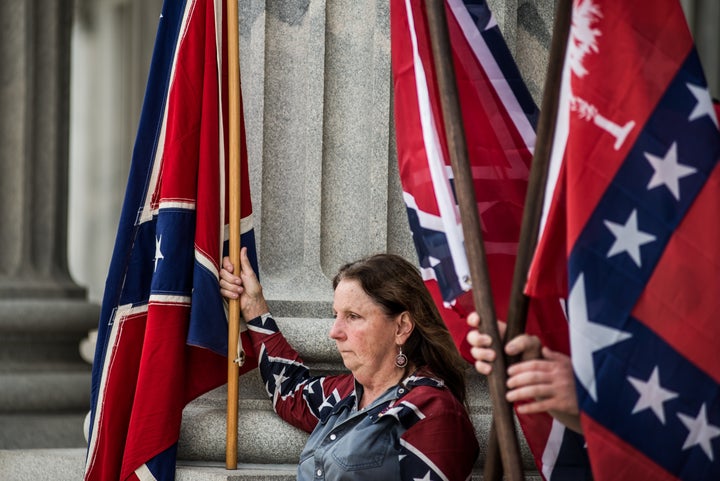
The last year has provided plenty of vivid examples that racism is alive and well in the United States: several high-profile police killings of young black men, the racially-motivated shooting of nine African-Americans in Charleston, South Carolina, and, most recently, the ongoing debate and protests over the removal of the Confederate flag.
While most white Americans acknowledge that racism is a problem in the U.S., white people are half as likely as black people to see it as a major problem. Three out of four white Americans say that racism is at least a "somewhat serious" national problem, compared to nearly nine out of 10 black people who say the same, according to a HuffPost/YouGov poll. However, many more black people consider it to be a "very serious" problem -- 68 percent of black respondents, versus 31 percent of whites.
Furthermore, a majority of white respondents say that racism is not really an issue in their own community and don't feel empowered to act upon it, despite recognizing it as a national problem.
One-tenth of white respondents said that "racism is an issue in my community and I'm able to take meaningful action against it." A quarter said that "racism is an issue in my community but there's not much I can do about it." But the majority -- 56 percent -- said that "racism isn't really an issue in my community” and thus, there wasn’t anything they could do to address it.
Only 22 percent of white people said they had confronted someone in person in the last year over a racist or prejudiced comment; 14 percent said they had confronted someone online. Just 8 percent said they'd contacted a politician or signed a petition about an issue related to racism, while 4 percent said they'd volunteered or donated to an organization that works to oppose racism. The overwhelming majority -- 65 percent -- said they hadn't done any of those things.
Still, nonwhite Americans were about as likely as white Americans to say they hadn't taken any of the above actions against racism.
Various experts have tried to unpack what’s happening in these polls. "It's easy to perceive the country in abstract to be racist, but it's easier to deny that your community specifically is racist because then it would be a reflection of you and make you feel responsible for not doing anything about it," explains Roger Fisher, the associate director of Intergroup Relations, a social justice education program at the University of Michigan that explores social identity in the context of power, privilege and inequality.
Robin DiAngelo, a racial justice consultant and former associate professor at Westfield State University, says the results suggest that many white people simply don't understand what racism is in practice.
Most white people believe that racism “occurs in individual acts committed by individual people who are either good or bad, and if you don't commit those acts, then you are good and there's no further issue,” DiAngelo says. There is also a misunderstanding that racism is “a conscious and explicit dislike,” and it’s often why people will cite having a black friend to show that they’re not racist. These two reasons, DiAngelo explains, make it difficult for white people to identify racism and be able to act upon it.
In order to address racism, it's necessary to acknowledge that it exists beyond interpersonal relations at the structural and institutional level, says Luke Harris, an associate professor of political science at Vassar College. Harris points to public policies that built the white middle class in the second half of the 20th century -- policies like the the National Housing Act of 1934 and 1937, a series of housing programs enacted to pull families out of the Depression, and the GI Bill, which provided federal funding to returning World War II veterans to go to college and purchase low-interest homes in the suburbs. These programs were denied to black Americans, sustaining segregation and providing opportunities for generations of white people, the benefits of which persist today. But it's difficult for white people to identify how historical policies have shaped their communities and their position in life, said Harris.
There are other systems that perpetuate racial disparities. Harris points to the disproportionate number of black males in the prison system -- one in 15, according to a Center for American Progress report, compared to one in 106 white men. And when convicted, black men often face longer prison sentences than white men for the same crime, according to a report from the U.S. Sentencing Commission.
Harris, DiAngelo and Fisher all say that white Americans might not identify racism in their own community due to the ongoing lack of serious dialogue across racial lines. Many Americans simply don’t have an opportunity to discuss racism with someone of a different race because they live in deeply segregated communities. Eighty percent of white respondents in our survey stated that they feel "somewhat comfortable" to "very comfortable" having conversations about race, but a 2013 survey by the Public Religion Research Institute found that white Americans list mostly other white people as being among their closest confidants.
The opportunity to talk to someone whose experience may differ from their own is one of the reasons Harris thinks the gay rights movement has made such progress in such a short time in the U.S., while the modern civil rights movement has stalled. "A lot of white Americans who were trying to sort out how they felt about [same-sex marriage], had gay people in their families [or] people they knew," he said. That helped personalize the issue and build support for marriage equality among straight Americans. But fewer white Americans have experienced the same opportunities when it comes to racial equality, he posits.
One place to begin, Fisher says is "to have constructive conversations” about race. “If we can have dialogue that begins with grace, love, dignity and demonstration that we recognize the humanity in one another, then we have a place to begin," he said.
The HuffPost/YouGov poll consisted of 1,000 completed interviews conducted June 24-29 among U.S. adults using a sample selected from YouGov's opt-in online panel to match the demographics and other characteristics of the adult U.S. population.
The Huffington Post has teamed up with YouGov to conduct daily opinion polls. You can learn more about this project and take part in YouGov's nationally representative opinion polling. Data from all HuffPost/YouGov polls can be found here. More details on the poll's methodology are available here.
Most surveys report a margin of error that represents some, but not all, potential survey errors. YouGov's reports include a model-based margin of error, which rests on a specific set of statistical assumptions about the selected sample, rather than the standard methodology for random probability sampling. If these assumptions are wrong, the model-based margin of error may also be inaccurate. Click here for a more detailed explanation of the model-based margin of error.
